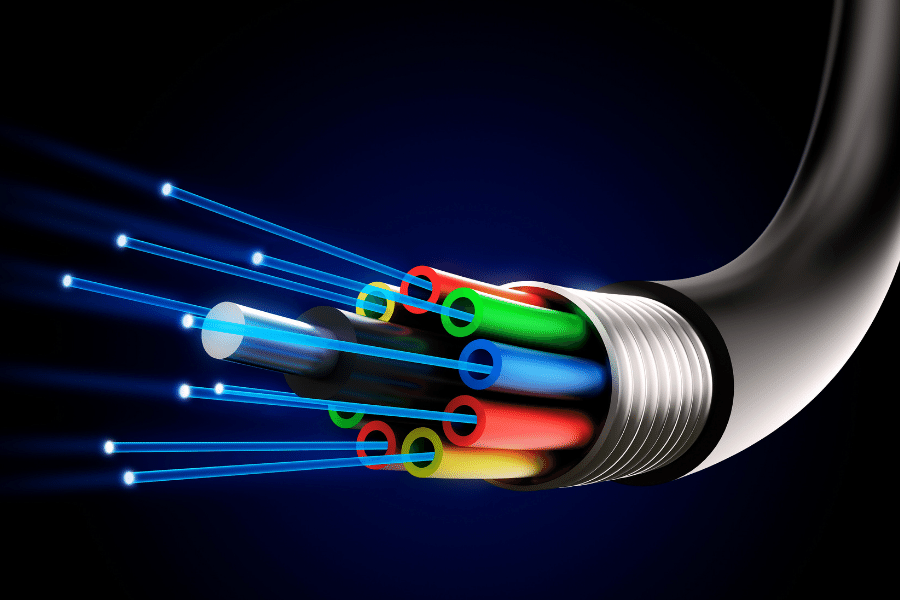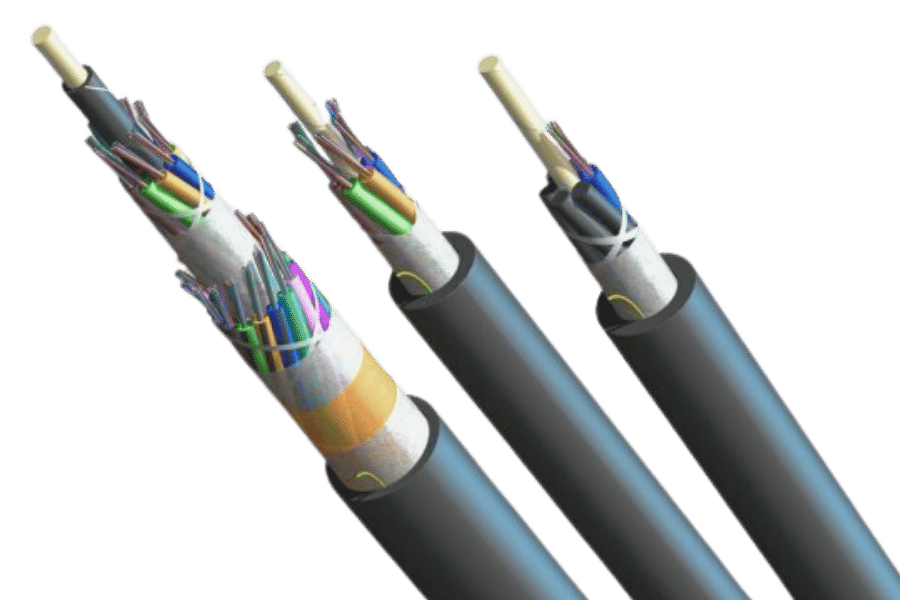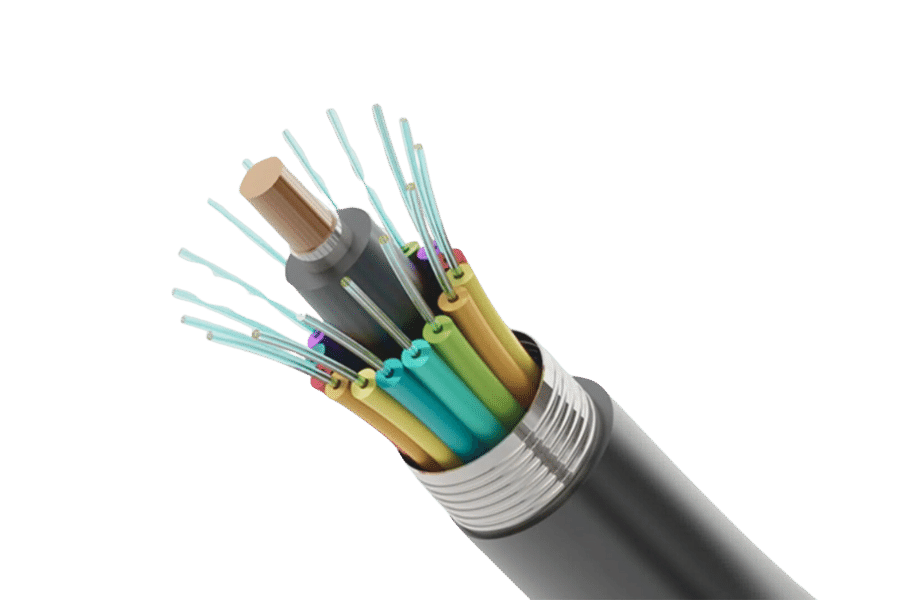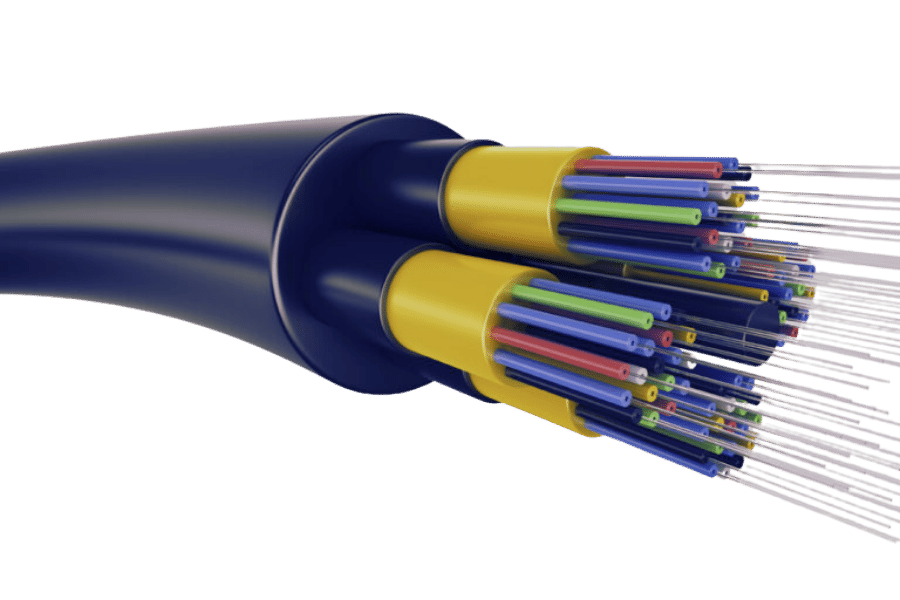Fiber optics technology is important to the telecommunications and data transmission industry. It sends information over long distances by converting electrical signals into light through small glass or plastic fibers, with very little signal degradation. Compared with copper cables, fiber-optic cables have larger bandwidths, faster speeds of data transfer, and are resistant to electromagnetic interference, among other things. In this post, we’re going to cover what you need to know about Fiber Optics, such as how it works. What are its main parts? Where can it be used? We’ll also take a look at some pros & cons associated with using this type of communication method and wrap up by giving all readers an in-depth understanding of what could potentially become one the most crucial developments in modern-day communication networks.
Table of Contents
ToggleWhat is Fibre Optics and How Does it Work?

Understanding Fiber Optics: The Basics
Fiber optics works by transmitting data as light signals through the use of thin strands of glass or plastic called optical fibers. Each optical fiber consists of a core, cladding, and protective coating. The core, which is located at the center of the fiber, carries the light signals. Surrounding this central region is the cladding that reflects any escaping light back into the core to prevent loss of signal strength. A laser or an LED (light-emitting diode) sends light pulses down the core to start off with. These signals are then decoded into electrical signals by photodetectors at their destination, where they are needed again for further processing. This technique ensures that information can travel over large distances without much degradation, thereby making fast communication possible while saving on power consumption during transmission and reception stages since only small amounts need to be used.
How Does Optical Fiber Transmit Data?
Light signals are transmitted via optic fibers by converting electric currents. These light signals then pass through the cable core of fiber optics. The data transmission process involves four steps, namely: signal generation, transmission, reception and decoding.
- Signal Generation: Data is represented by optical pulses that are produced by a light source such as LED or laser.
- Transmission: Light pulses travel through the core of an optical fiber surrounded by cladding, which traps it inside using total internal reflection.
- Reception: Photodetectors change these light pulses back into electrical signals at the receiving end.
- Decoding: The converted electrical signals are decoded to their original form, thus completing the entire data transmission process.
This technique guarantees fast rate of information transfer with least signal loss hence efficient and reliable communication can take place.
The Role of Light Signals in Fiber Optic Technology
The part played by light signals in fiber optic technology cannot be overemphasized as it is what makes fast and effective data transmission possible. This is because light can travel extended lengths with minimum attenuation and can carry much information at very high rates. When a laser or an LED changes electrical signals to light pulses, the latter are then injected into the optical fiber core. The cladding around the core ensures that light is trapped inside through total internal reflection (TIR), thereby preserving signal quality over long distances. At the other end, photodetectors convert these received power bursts into electric currents, which can be decoded and utilized accordingly. Thus, this method results in a reliable means of communication characterized by efficiency where most, if not all, systems heavily depend on fiber optics for their operation.
What are the Different Types of Fiber Optic Cables?

Single-mode Fiber vs. Multimode Fiber
Single Mode Fiber:
Single-mode optical fiber is a type of cable that transmits light signals over long distances with a small core diameter, usually 8-10 microns. The smaller core reduces reflection and preserves the signal quality of light. It allows for faster data transmission over longer distances and provides higher bandwidth too. That’s why single-mode fibers are mostly used in high-speed networks like the backbones of the internet or long-haul telecommunication lines where maintaining the quality of the signal for extended periods is essential. In addition to being able to work on higher wavelengths such as 1310nm and 1550nm, single-mode fiber has less attenuation at these wavelengths; hence, it can transmit data at faster rates over larger ranges.
Multimode Fiber:
On the other hand, multimode fiber optic cables have a larger core diameter ranging from 50 to 62.5 microns which can support multiple simultaneous propagating light signals or modes. This causes modal dispersion, where different lights arrive at different times, inducing potential distortions in signals over longer distances traveled by them. With this characteristic, they are suitable for short-distance communication systems covering up to about 2 kilometers – such as data centers within buildings (intra-building), local area networks (LANs) or enterprise networks. They operate typically at lower wavelengths like 850 nm and 1300 nm and offer increased bandwidths over shorter link lengths but cannot be used effectively in long-distance communication due to their high signal attenuations.
The choice between these two types depends mainly on factors such as distance requirements and the amount of data needed to be transmitted through cables within certain periods of time (bandwidth). Single-mode fibers should be employed when constructing large capacity networks spanning many miles, while multimode cables come into play when dealing with short-range connections necessitating huge amounts of bandwidth consumption per unit length covered by them.
Types of Fiber Optic Cable Strands
Simplex Fibre Optic Strands:
Simplex fiber optic cables have only one optical fiber strand for unidirectional data transfer. They are often used when there is a need for point-to-point communication or where one-way communication is sufficient, such as long-distance telecommunication lines or single-channel Ethernet connections.
Duplex Fibre Optic Strands:
Duplex fiber optic cables consist of two fiber strands that allow bidirectional data transmission. They are used in places where two-way communication is necessary, such as full-duplex Ethernet networks and fiber optic transceivers. There are two types of these cables: half-duplex (alternating transmission) and full-duplex (simultaneous transmission).
Ribbon Fiber Optic Strands:
Ribbon fibre optic cables comprise multiple fibres bundled together in parallel within one encapsulated structure which facilitates high-density connections and mass fusion splicing thus suitable for use in data centers, network backbones among other high-capacity environments. They provide a space-saving solution for areas with many fiber connections required.
Knowing about the different types of fiber optic cable strands will help you choose the right one for your specific communication needs so that you can achieve optimum performance and efficiency in different network setups.
Choosing the Right Fibre Optic Cable for Your Needs
Whenever you need to choose a fiber optic cable that is suitable for your needs, there are a few things that must be taken into consideration in order to ensure efficiency and best performance. First, you will have to decide on the bandwidth requirements and distance of the transmission system. For long-distance communications without any loss of signal, it is best to use single-mode fiber optic cables because they can transmit one light mode over long distances. On the other hand, multi-mode fibers may be preferred where lower cost and higher data rates are needed within enterprise networks or data centers because they have a large core size, which allows them to carry more than one light mode.
Secondly, consider where these cables shall be installed by assessing their installation environment. In most cases, indoor setups demand flexible designs that are less prone to interference, while outdoor areas need strong jackets around robust cables capable of withstanding harsh weather conditions and physical abuse. Moreover, think about future scalability; ribbonized fibers work well for densely populated links and could accommodate increased traffic volumes over time.
The last thing that may affect this decision is usually related to money. Single-mode cords tend to be more expensive due to the accuracy required during manufacturing processes but, in turn, save costs for large networks over an extended period. Conversely, multimode fibers might offer cost-saving benefits within limited areas of networking needs. By considering all these factors i.e, transmission requirements, budget limitations, environmental conditions, etc., it becomes possible for someone to select a fiber-optic cable type appropriate for their specific application.
What are the Advantages and Disadvantages of Fiber Optics?

Advantages of Fiber Optic Technology
- High Capacity: In terms of channel capacity, fiber optic cables have a much larger bandwidth than copper cables, which can transmit huge quantities of data at very fast speeds. This attribute suits them best for applications that require heavy resources like streaming services, video conferencing, or large file transfers.
- Weak Signal Attenuation: Fiber optics undergo minimum signal loss over long distances thereby ensuring quality and reliability in data transmission. This becomes particularly useful when dealing with wide area networks (WANs) or other types of communication links covering great geographic areas.
- Resistance to Electromagnetic Interference: Unlike copper wires, fiber optic systems are not affected by electromagnetic interference hence they provide more secure means of transmitting information. It is important in places where there is strong electric noise such as factories or power plants where signals may get distorted if transmitted through metallic conductors.
- Confidentiality: The fact that it is hard to tap into a fibre-optic cable without being noticed makes this type of communication line more secure than any other wire based connectivity system. Therefore many organizations opt for these kinds of connections so as to prevent eavesdropping and unauthorized access to their sensitive data.
- Portable and Tough: In comparison with copper wires, fibers are lightweight yet rugged making them easy to install and maintain. Moreover they can withstand extreme temperatures changes coupled with harsh environmental conditions thus making them highly dependable over an extended period.
Disadvantages of Using Fibre Optics
- Costs at the Beginning: To begin with, fiber optic cables require high initial costs. This includes the price of specialized equipment, cables and skilled workers. Smaller businesses or those on a tight budget might find this difficult to overcome.
- Fragility: Comparatively speaking fiber optic cables can be seen as fragile next to their copper counterparts. They can be damaged physically when being installed or by accidental mechanical stress thus they need careful planning as well as handling.
- Complex Installation and Maintenance: Specialized knowledge and tools are required during installation and maintenance of fiber optic networks; this makes it complex. Technicians should be trained on how to splice fibers, handle them among other things which may complicate deployment increasing labour cost. Diagnosis and repair of these types of networks also pose greater challenges compared to traditional systems that are based on metals.
Comparing Fibre Optic and Copper Cable
To compare fiber optic and copper cables, you should think about the following:
- Bandwidth and Speed: Fiber optic cables have much higher bandwidths and faster data transfer speeds than copper ones. Copper cable technology limits it to 10 Gbps at most while fiber can support up to or more than 100 Gbps. Fiber optics are therefore better for high demand applications like streaming, large file transfers or high capacity networking.
- Distance and Signal Integrity: Fiber optic cables can keep signals strong over longer distances without amplification – sometimes over several kilometers. On the other hand, copper loses quality as distance increases beyond 100 meters, thus requiring signal boosters, which add complexity and cost to a system.
- Interference and Reliability: Since they use light to transmit information, fibers are immune from Electromagnetic Interference (EMI) and Radio Frequency Interference (RFI). Hence, this gives them more stability. Connecting two devices, especially where there is much electrical activity around, like factories where radios interfere with each other every second, may need fiber optics because even though copper cables have shielding, they still get affected by these interferences, leading to loss of data or problems in communication reliability between them.
- Cost of installation: The initial set-up fee for installing an optical fiber line is higher compared with that of the copper wire due to the expensive materials used, the specialized tools needed, and the skilled workforce requirements. However, once installed, fiber costs less in terms of maintenance since it hardly requires fixing unless acted upon by external forces. On the other hand, copper wires are cheaper during their laydown phase but tend to become expensive over time because they wear out easily, needing frequent replacements, which demand labor intensity, thereby increasing operational expense.
- Environmental Impact & Durability: Fiber optic cables are highly resistant against temperature variations moisture levels corrosive substances hence making them withstand harsh environmental conditions better than any other type of cable such as copper wires which can be affected by these elements leading to increased maintenance costs coupled with shorter lifespans in operationally challenging areas.
In conclusion, even though it may be costly at first, fiber optic cable investment is still preferable to copper due to its benefits in terms of speed, distance reliability, and long-term cost. On the other hand, if there are budget constraints, shorter, less demanding applications can still use copper cables.
How are Fiber Optics Used in Different Industries?

Role of Optical Fiber in Telecommunications
In current communications systems, it is important to use optic fibers as they can carry huge amounts of information over long distances without losing it or causing any damage. Fiber optics are used for high-speed internet connections, television signals, and telephone calls in telecommunication networks. It is capable of accommodating large amounts of data, which have increased greatly due to streaming services, online gaming, etc., this being made possible by its ability to provide higher bandwidths. Another advantage is that optical fiber does not easily get affected by electromagnetic interference like copper wires, hence ensuring continuous and reliable communication signals all the time. Scalability, together with efficiency, makes optic fiber necessary for backbone infrastructure as well as residential/ commercial last-mile connectivity solutions.
Using Fiber Optics in Computer Networking
Computer networks depend on fiber-optic cables for fast data transmission and uninterrupted connection. Compared with copper cables, fiber optic ones have much larger bandwidth, which means higher rates of data transfer – this is necessary for many modern applications that involve massive amounts of information like videoconferencing, cloud storage, or big-scale databases. Moreover, the latency of fibers is lower than that of any other type, which allows it to exchange packets faster and thus perform better in real-time tasks. Fiber optics are also resistant to interference caused by electromagnetic fields; hence, they can be used even in areas where there is strong magnetic activity without losing signal quality all the time. Furthermore, this method offers more security as it’s hard to intercept light beams without being noticed, so sensitive materials often get protected using them instead. Additionally, this feature makes them preferred for keeping secret knowledge safe, too. In terms of scalability, nothing beats fiber optics since its infrastructure can easily adapt to growing network needs, making such investments future-proof against surging technological requirements.
Applications of Fiber Optic Cables in Data Centers
Because they handle fast data transmission and can cope with large bandwidth requirements, fiber optic cables are essential in data centers. Fiber optics enable efficient connectivity between servers, storage systems, and networking equipment, thus significantly improving operational performance. They also support the scalability of data centers through dense connections that allow for the integration of extra hardware without slowing down or affecting performance. Additionally, over long distances, signal integrity is better maintained by fiber optics, which is very important for big data center environments. This technology furthermore reduces the space needed for cabling, thereby optimizing it and enabling more flexibility when designing infrastructures within data centers. Likewise, all these traits make fiber optic cables a cornerstone for contemporary high-performance operations within them, according to leading sources.
Common Issues and Solutions with Fiber Optic Cables

Dealing with Attenuation in Fibre Optic Networks
The most important thing when it comes down to making sure that your network works at its best is dealing with attenuation. The strength of a signal decreases as it moves along an optical fiber cable, which is known as attenuation.
As stated by another source, the key to reducing attenuation includes using good-quality cables and installing them properly. Fiber-optic cables should be handled carefully so that they do not get micro bends or macro bends because these are two things that can cause more attenuation than usual. Another authoritative site stresses the need for clean connectors and splices because dirtiness and imperfection may greatly increase signal loss through them. Finally, testing and monitoring the network regularly with an OTDR (Optical Time-Domain Reflectometer) will help you find weak points in time for necessary actions to be taken. All these measures work together towards minimizing attenuation thus keeping fiber optic networks efficient and intact.
Preventing Interference in Fiber Optic Technology
Fiber optic technology has almost no electromagnetic interference (EMI) because fiber optic cables transmit data through light rather than electrical signals. Nevertheless, there are problems that may occur due to physical disruptions and poor installations. Hence, it is very important to ensure the proper routing and handling of cables so as to avoid any physical stress or damage to them. Furthermore, signal integrity can also be lost due to low-quality connectors and splices used, which may lead to even more serious issues with its operation. In addition, strict installation standards and guidelines should be followed in order not only to reduce external interferences but also to prevent signal degradation throughout its path. Regular maintenance inspections enable early identification of potential problems thereby maintaining optimum performance levels for the entire fiber optic network.
Maintaining and Repairing Fiber Optic Cables
To ensure that the network lasts long and remains reliable, it is important that fiber-optic cables are effectively maintained and repaired. Cleaning connectors, checking for physical damage and proper cable management to avoid bends and kinks are part of regular inspection and maintenance. In terms of fixing them, using a fusion splicer to position fiber ends accurately and then merge or join them together is very important because this helps reduce signal loss and maintain cable structure integrity. Apart from this method being used during repairs, another way through which faults can be detected along the whole length of a cable with high precision so that they are localized for repair is by use of an Optical Time Domain Reflectometer (OTDR). Protecting enclosures plus employing necessary controls over the environment also contributes greatly towards ensuring continuous operational efficiency by preventing external attacks on fiber optic infrastructure.
Frequently Asked Questions (FAQs)
Q: What is the meaning of optical fiber technology?
A: By optical fiber technology, I mean the employment of thin, flexible fibers made of glass or plastic for sending data as light signals over long distances. This enables faster and more efficient communication than traditional copper wires.
Q: How does information get transmitted via fiber optics?
A: In fiber optics, information is transmitted by converting electrical signals into light pulses. These travel through the core, bouncing off cladding until their destination with little signal loss over large distances.
Q: What’s the difference between fiber optics and copper wire?
A: Comparatively, fiber optics use strands of either glass or plastic in order to send light signals which enable quicker data transmission rates and longer range without electromagnetic interference while on the other hand copper wires transmit electrical signals that are susceptible to interference and signal degradation over shorter distances.
Q: Why does optical fiber technology require cladding?
A: Cladding is important because it surrounds the core of a fiber optic cable. The refractive index of this layer is lower than that of the core thereby causing reflection back towards inside which helps in keeping light pulses within the core where they belong. This ensures that data is sent more efficiently with minimal loss in signal quality.
Q: Out of what materials are fiber-optic cables manufactured?
A: Fibre-optic cables can be made from glass or plastics. An outer covering protects an inner cladding that surrounds a central conductor responsible for carrying any necessary light signals along its length. The rest involves some technicalities, so let’s leave it at that!
Q: How thin are the strands of glass used in fiber optics?
A: The diameter of the glass strands utilized in optical fibers is extremely small, usually approximately the size of a human hair. This feature allows light signals to be transmitted over great distances with little loss.
Q: What are the different types of fiber optic cables?
A: Fiber optic cables come in two main varieties: single-mode and multimode. The former has a narrower core diameter and is employed for long-haul data transmission, whereas the latter uses a wider core diameter for shorter distances.
Q: How effective is a fiber connection for internet service?
A: A fiber connection for internet service is very effective as it ensures fast and reliable data transfer rates that are constant throughout its usage period, making it suitable for streaming or online gaming among others which require high bandwidths.
Q: What is a “fiber to the home” (FTTH) connection?
A: Fiber to the home (FTTH) is an Internet connectivity option where individual houses are connected directly with optical fiber cables instead of using traditional DSL or cable lines. It offers faster speeds and greater reliability compared to other methods like DSL or cable connections.
Q: How do fiber lasers utilize optical fiber technology?
A: Fiber lasers work by using rare-earth-doped glass fibers as gain media. The waveguide properties within these fibers allow efficient generation and amplification of laser light through their being utilized as an active medium pumped optically or electrically so that population inversion can occur at some point along their length.
